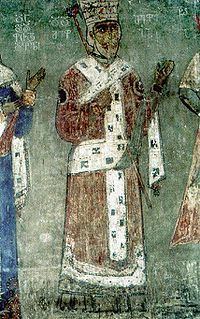Reign 1156–1184 Name George of Parents Demetrius I of Georgia | Role King Grandparents David IV of Georgia Died March 27, 1184 | |
 | ||
Issue TamarRusudan, sebastokratorissa Children Tamar of Georgia, Rusudan, daughter of George III of Georgia Similar People Tamar of Georgia, George IV of Georgia, David IV of Georgia, David Soslan, Heraclius II of Georgia | ||
George III (Georgian: გიორგი III) (died 27 March 1184), of the Bagrationi dynasty, was the King of Georgia from 1156 to 1184. His reign was part of what would be called the Georgian Golden Age - a historical period in the High Middle Ages, during which the Kingdom of Georgia reached the peak of its military power and development. George was the father of Queen Tamar the Great.
Contents
Life
He succeeded on his father Demetrius I's death in 1156.
He changed his father's defensive policy into a more aggressive one and resumed offensive against the neighboring Seljuk rulers in Armenia. With his ascent to the throne, George III launched a successful campaign against the Seljuk sultanate of Ahlat (the Shah-Armen State) in 1156. George took and annexed the Armenian cities of Ani and Dvin in 1161–1162. However, the Seljuk counterattacks made the King to cede Ani to a Muslim ruler on the terms of vassalage. The city was finally incorporated into the Georgian Kingdom in 1173. Throughout this period, the Georgian army was swelling with Armenian volunteers, enthusiastically participating in the Iiberation of their country. In 1167, he marched to defend his vassal Shah Aghsartan of Shirvan against the Khazar and Kipchak assaults and strengthened the Georgian dominance in the area.
In 1177, the nobles of the realm rose against the king and declared Prince Demna (Demetrius) a "true and lawful King of Georgia". Being a son of George III's late elder brother David V, Demna was considered by many as a legitimate pretender to the Georgian throne. Approximately 30,000 rebel forces under Demna's father-in-law Ioane Orbeli strengthened their positions at the citadel of Lore. The fortress was besieged by the royal army. Throwing himself and his followers on the mercy of his uncle, he was blinded and castrated and most of his in-laws murdered.
In 1178, George III appointed his daughter and heiress Tamar as heir apparent and co-ruler to forestall any dispute after his death. However, he remained co-regent until his death in 1184. He was buried at Gelati Monastery, western Georgia.
Marriage and children
In ca. 1155, George married Burdukhan (Gurandukht), daughter of Khuddan, King of Alania. They had two daughters:
Title
The Most High King George, by the will of our Lord, King of Kings of the Abkhazians, Kartvelians, Ranians, Kakhetians and the Armenians, Shirvanshah and Shahanshah and Master of all the East and the West.
